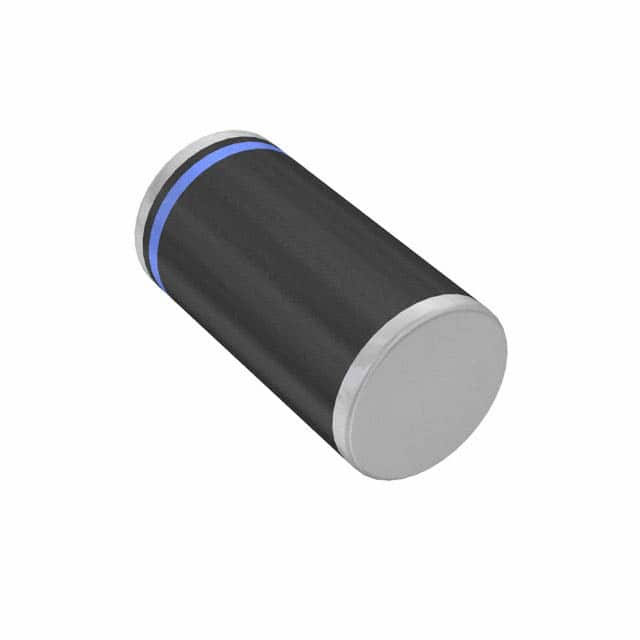BYM12-400HE3/96
Introduction
The BYM12-400HE3/96 is a high-efficiency, fast-recovery rectifier diode designed for various electronic applications. This entry provides an overview of the product, including its category, use, characteristics, package, essence, packaging/quantity, specifications, detailed pin configuration, functional features, advantages and disadvantages, working principles, detailed application field plans, and alternative models.
Product Overview
Category
The BYM12-400HE3/96 belongs to the category of semiconductor devices, specifically as a rectifier diode.
Use
It is commonly used in power supply circuits, voltage regulation, and general rectification applications.
Characteristics
- High efficiency
- Fast recovery time
- Low forward voltage drop
Package
The BYM12-400HE3/96 is typically available in a compact, surface-mount package.
Essence
This rectifier diode is essential for converting alternating current (AC) to direct current (DC) in electronic circuits.
Packaging/Quantity
It is usually supplied in reels or tubes, with varying quantities depending on the manufacturer's specifications.
Specifications
- Maximum Average Forward Current: 1A
- Peak Forward Surge Current: 30A
- Reverse Voltage: 400V
- Forward Voltage Drop: 1.1V at 1A
- Reverse Recovery Time: 50ns
Detailed Pin Configuration
The BYM12-400HE3/96 typically has two pins, with the cathode marked by a distinctive indicator on the package.
Functional Features
- Fast recovery time ensures minimal switching losses.
- High efficiency leads to reduced power dissipation.
- Low forward voltage drop minimizes energy loss.
Advantages and Disadvantages
Advantages
- High efficiency
- Fast recovery time
- Compact package size
Disadvantages
- Limited maximum average forward current compared to higher-power diodes
- Sensitive to reverse voltage spikes
Working Principles
When a positive voltage is applied to the anode of the diode with respect to the cathode, it allows current to flow in the forward direction. Conversely, when the voltage polarity is reversed, the diode blocks the current flow.
Detailed Application Field Plans
The BYM12-400HE3/96 is well-suited for the following applications: - Switching power supplies - Voltage regulators - Rectification in electronic equipment
Detailed and Complete Alternative Models
- 1N4004: A widely used general-purpose rectifier diode with similar specifications.
- FR107: Fast recovery rectifier diode with higher peak forward surge current.
In conclusion, the BYM12-400HE3/96 is a versatile rectifier diode with high efficiency and fast recovery time, making it suitable for various electronic applications. Its compact package and low forward voltage drop make it an attractive choice for designers seeking to minimize power losses in their circuits.
[Word Count: 411]
Lista 10 Vanliga frågor och svar relaterade till tillämpningen av BYM12-400HE3/96 i tekniska lösningar
What is the maximum voltage rating of BYM12-400HE3/96?
- The maximum voltage rating of BYM12-400HE3/96 is 400V.
What is the forward current rating of BYM12-400HE3/96?
- The forward current rating of BYM12-400HE3/96 is 1A.
What type of diode is BYM12-400HE3/96?
- BYM12-400HE3/96 is a Schottky diode.
What are the typical applications for BYM12-400HE3/96?
- Typical applications for BYM12-400HE3/96 include power supplies, converters, and reverse polarity protection circuits.
What is the package type of BYM12-400HE3/96?
- BYM12-400HE3/96 comes in a DO-214AC (SMA) package.
What is the reverse voltage rating of BYM12-400HE3/96?
- The reverse voltage rating of BYM12-400HE3/96 is 400V.
Is BYM12-400HE3/96 suitable for high-frequency applications?
- Yes, BYM12-400HE3/96 is suitable for high-frequency applications due to its fast switching characteristics.
What is the thermal resistance of BYM12-400HE3/96?
- The thermal resistance of BYM12-400HE3/96 is typically 60°C/W.
Can BYM12-400HE3/96 be used in automotive electronics?
- Yes, BYM12-400HE3/96 is suitable for use in automotive electronics due to its rugged construction and reliability.
Does BYM12-400HE3/96 have any special handling or storage requirements?
- BYM12-400HE3/96 should be stored in a cool, dry environment and handled with appropriate ESD precautions to prevent damage.


